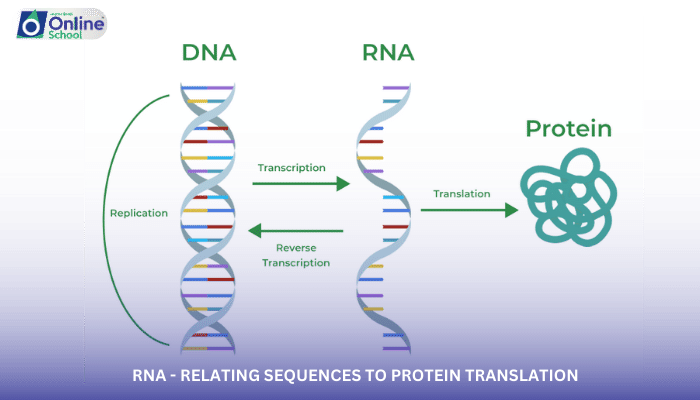
Learning Outcomes
By the end of this lesson, students should be able to:
i. Explain the role of RNA as a messenger molecule in the process of protein translation, transferring genetic information from DNA to ribosomes.
ii. Describe the three main types of RNA molecules: messenger RNA (mRNA), ribosomal RNA (rRNA), and transfer RNA (tRNA), and their distinct functions in protein synthesis.
iii. Understand the concept of codons and anticodons, the complementary nucleotide triplets in mRNA and tRNA that determine amino acid incorporation during translation.
iv. Explain the steps involved in protein translation, including initiation, elongation, and termination, and how RNA molecules guide these processes.
v. Appreciate the significance of RNA sequences in protein synthesis, enabling the translation of genetic information into the functional molecules that drive cellular processes.
Introduction
RNA, a crucial molecule in the machinery of life, plays a pivotal role in protein synthesis, the process by which genetic information encoded in DNA is translated into functional proteins. RNA acts as a messenger molecule, carrying the genetic code from DNA to ribosomes, the cellular factories where proteins are assembled. Understanding the relationship between RNA sequences and protein translation is essential for comprehending the intricate processes that underlie life's fundamental activities.
i. The Trio of RNA Molecules: A Functional Orchestra
Three main types of RNA molecules are involved in protein synthesis:
Messenger RNA (mRNA): The messenger, carrying the transcribed genetic code from DNA to ribosomes.
Ribosomal RNA (rRNA): The structural component of ribosomes, providing the framework for protein assembly.
Transfer RNA (tRNA): The adapter molecule, carrying specific amino acids to the ribosome based on the mRNA codon sequence.
ii. Codons and Anticodons: The Molecular Language of Translation
The genetic code is translated into amino acids using codons, triplets of nucleotides on mRNA, and anticodons, complementary triplets on tRNA. Each codon specifies a particular amino acid, and the correct pairing of codons and anticodons ensures accurate amino acid incorporation during translation.
iii. The Dance of Translation: A Multi-Step Process
Protein translation is a multi-step process that involves the coordinated action of various molecules, including RNA, ribosomes, enzymes, and amino acids:
Initiation: The ribosome assembles on the mRNA, and the tRNA carrying the first amino acid is positioned at the start codon.
Elongation: The ribosome reads the mRNA codon by codon, and the corresponding tRNA carrying the matching amino acid delivers the amino acid to the growing protein chain.
Termination: Upon reaching a stop codon, the ribosome disassembles, releasing the newly synthesized protein.
iv. RNA Sequences: Guiding the Translation Symphony
The sequence of nucleotides in RNA molecules, particularly mRNA, determines the order of amino acids in the corresponding protein. This precise translation of the genetic code is essential for producing functional proteins with specific structures and functions.
RNA sequences play a crucial role in protein translation, the process by which genetic information is transformed into the proteins that drive cellular processes. The three types of RNA molecules, mRNA, rRNA, and tRNA, work in concert to translate the genetic code, ensuring that the correct amino acids are incorporated into the growing protein chain. Understanding the relationship between RNA sequences and protein translation provides insights into the molecular mechanisms that underpin the diversity and complexity of life.